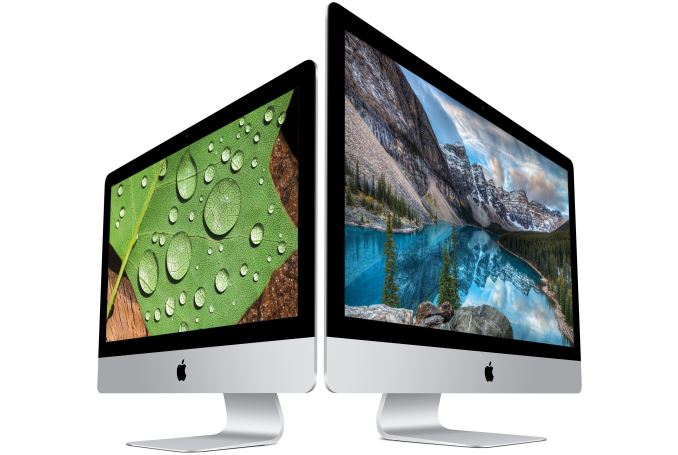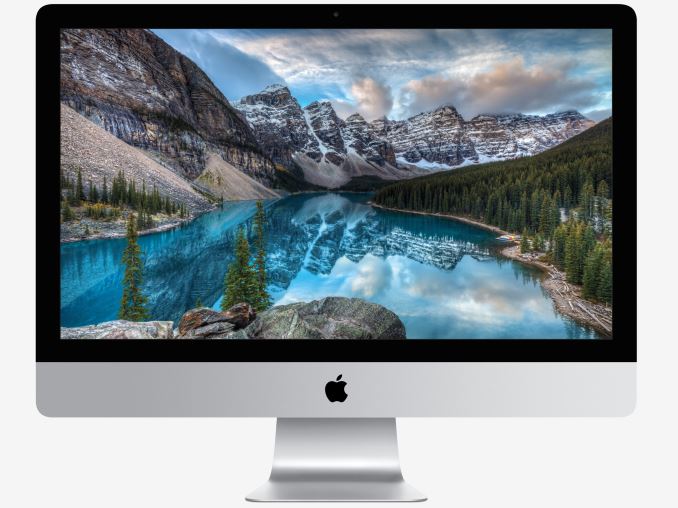Apple Updates The iMac Line With a 21.5" Retina Model
by Brandon Chester on October 13, 2015 10:55 AM EST
Almost exactly one year ago Apple launched their first ever iMac with Retina display at their October 2014 event. The launch had a number of surprises, with one of the biggest being the fact that it would sell for $2499 despite its 5K display matching the resolution of Dell's UP2715K which had an intended launch price of $2999. While Apple doesn't appear to be planning any more events for this year, they have decided to ship an upgrade to their existing 27" iMac with 5K Retina display, and have also introduced a brand new 21.5" iMac with Retina 4K Display. You can view the specs for the base models of Apple's new 2015 iMacs in the chart below.
| Apple iMac With Retina Display 2015 | ||||
| Model | 21.5" Base | 27" Base | ||
| CPU | 3.3GHz Core i5-5675C/R (Broadwell) |
3.5GHz Core i5-6500 (Skylake) |
||
| GPU | Intel Iris Pro 6200 | AMD Radeon R9 M380 (2GB) | ||
| Display | 21.5" 4096 x 2304 IPS LCD | 27" 5120 x 2880 IPS LCD | ||
| Memory | 8GB 1867MHz DDR3 (LPDDR3 in 21.5") | |||
| Storage | 1TB 5400RPM HDD | 1TB 7200RPM HDD | ||
| Price | $1499 | $1799 | ||
Just briefly touching on the 27" iMac, it's mainly an upgrade to the internal hardware from its original Intel Haswell platform. The CPU in the base model is now a 3.5GHz quad core i5-6500 which is an Intel Skylake part, and the upgraded options include a 3.3GHz i5-6600 and what is seemingly the 4.0GHz i7-6700K which would typically be an unlocked part, although I wouldn't expect any overclocking to be accessible. The GPU is now AMD's R9 M380. The GPUs also move to AMDs M300 series, with an M380 in the base model, an M390 in the mid tier, and an M390X in the high end model, all with 2GB of GDDR5 memory. There's also the M395X with 4GB of GDDR5 memory available as a BTO option.
The 21.5" iMac is the most interesting of the two new devices purely due to it being a brand new machine. Apple calls it the iMac with 4K Retina display, and it means that there are now Retina display options for both display sizes of the iMac. Speaking of the display, it's a 21.5" 4096 x 2304 IPS panel, which is higher than the 3840 x 2160 UHD resolution shipping on most "4K" displays, and it has enough horizontal and vertical resolution to natively display actual DCI 4K content.
In addition to the 21.5" model's new HiDPI display, both models of the iMac receive a boost to their color gamuts. Apple is now claiming support for the DCI-P3 gamut which is used in digital projection movie theaters, and this has been achieved by moving from a WLED backlight array to something similar to GB-r LEDs in order to increase the range of spectral emissions. What will be interesting to see is if Apple allows users to revert to the sRGB color space, which would require the inclusion of a 3D LUT that could also be used for more accurate self-calibration than the past.
I do question the choice of DCI-P3 over Adobe RGB though. Apple claims that most cameras can capture a wider color range than sRGB, which is true, but in my experience they'll usually only offer Adobe RGB as the other option. The DCI-P3 gamut is more similar to Adobe RGB than sRGB is, but it's definitely not the same and so there will be some error there when working in Adobe RGB without the correct gamut on the display. That being said, the fact that both displays can natively display DCI 4K content means they could theoretically be used for video editing, but I question the viability of mastering films for cinema projection with the processing power available in an iMac.
Beyond the display, the 21.5" iMac with 4K Retina display seems to stick with Intel's Broadwell platform rather than Skylake, as Apple needs to ship a part with Iris Pro graphics in order to drive the display. The CPU used is the 3.3GHz i5-5675C/R, with it being unclear whether it's the C or the R SKU which would mean a socketed or a BGA CPU respectively. I doubt many people would be adventurous enough to open up the chassis and replace the CPU even if it was possible anyway.
Apple has also brought down the cost of the Fusion Drive upgrade, but it comes with a sacrifice. The 1TB Fusion Drive now only has a 24GB flash memory segment, while it was previously 128GB. Both the 2TB and 3TB Fusion Drive options still come with 128GB of flash storage. While the 1TB Fusion Drive may still be worth it on the 21.5" iMac purely due to how slow 5400RPM HDDs are, it's hard to stomach paying $100 for 24GB of NAND, and I would definitely just stick with the standard HDD if I were buying the base model 27" iMac.
Both new Retina iMacs are available for purchase on the Apple Online Store, with shipping times as early as one business day. BTO configurations will obviously take longer depending on which customizations are chosen. The 21.5" iMac with 4K Retina display starts at $1499. The 27" iMac with 5K Retina Display starts at $1799, with the 3.2GHz R9 390M + 1TB Fusion Drive model at $1999 and the high end 3.3GHz i5, R9 M395 + 2TB Fusion Drive model at $2299.











46 Comments
View All Comments
TEAMSWITCHER - Tuesday, October 13, 2015 - link
"I am doing that right now with my 3yr old iMac whose internal HD has started failing"I don't think you're helping to dismiss the notion that any type of a spinning disk locked away in the sealed-architecture of the iMac is a very bad idea.
extide - Tuesday, October 13, 2015 - link
You completely misunderstood his comment. He says while it's hard to stomach the $100 on the 21" he would do it, but the second part of his comment is about the 27" iMac, with the 7200 RPM drive. I would personally even avoid that, but in any case you still completely misunderstood him. Although the way it is worded is a little bit confusing at first.repoman27 - Tuesday, October 13, 2015 - link
The non-Retina 21-inch models got the Broadwell treatment as well, so the CPU options are:Core i5-5250U, Core i5-5575R, Core i5-5675R and Core i7-5775R for the 21.5-inch and
Core i5-6500, Core i5-6600 and Core i7-6700K for the 27-inch.
24 GB of flash for the 1 TB Fusion drive sucks. There really is zero excuse for shipping the non-fusion version at that point, and $100 for the upgrade is absolutely insulting.
repoman27 - Tuesday, October 13, 2015 - link
And what's up with the Skylake 27-inch models listing DDR3-1867 SDRAM? I thought only DDR4 was supported at 1867 MHz.8steve8 - Tuesday, October 13, 2015 - link
no usb-c?that's pretty disappointing.
Impulses - Tuesday, October 13, 2015 - link
Even tho I bought a specific Skylake mobo because it had USB Type C, I fail to see how it's very relevant on a desktop system now or even a few years down the line...Even if it were included it's basically be for data transfer only as I'm assuming many pic the alt modes will require different controllers and future drives that may be incompatible with current hardware.
And besides, couldn't you just use a normal A to Type C cable for almost everything on a desktop? It's a different story on a laptop where space is at a premium and there may be device charging concerns...
8steve8 - Tuesday, October 13, 2015 - link
isn't power delivery 2.0 is for usb-c to usb-c only?i'm not saying you couldn't make it work without USB-c, but why have to workaround a limitation on a skylake high end desktop? imagine all the ports they have, and an extra usb-c port or two... what would be the downside?
repoman27 - Tuesday, October 13, 2015 - link
What is relevant to desktop Skylake systems now and in the future is Alpine Ridge. Which = Thunderbolt 3, USB 3.1 Gen 2, external GPU support and all of it over USB Type-C. It's most of the significant new technologies that Intel managed to deliver for this platform, technologies that have generally been championed by Apple, and yet not present here. That sucks, because it's unlikely Apple will refresh the iMac line for another 12 months or whenever Skylake Refresh (a.k.a Kaby Lake) finally trickles out.osxandwindows - Wednesday, October 14, 2015 - link
thunderbolt 3 and usb c will be a mac redesignBring back map 17
osxandwindows - Monday, October 19, 2015 - link
mbp17*